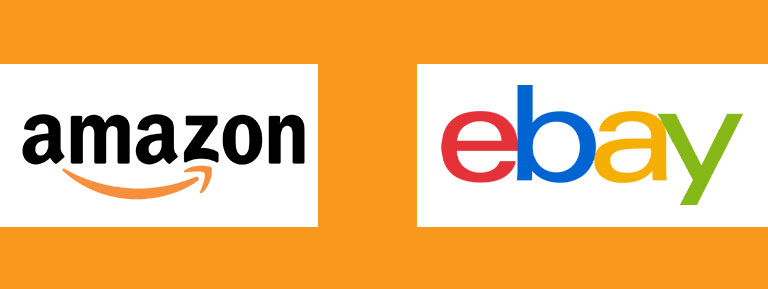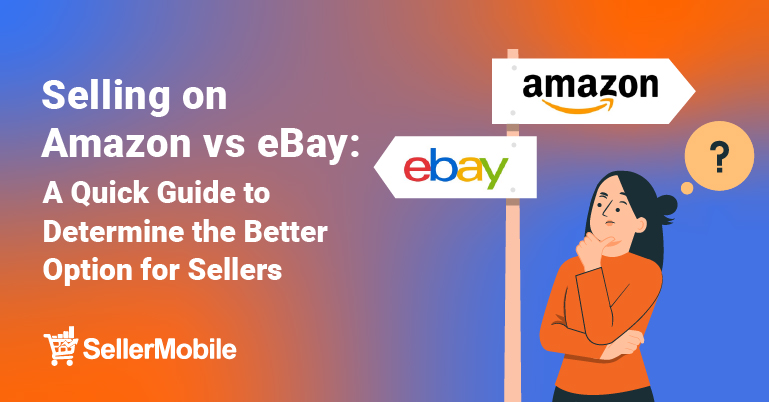Discovering the most effective online trade market can be challenging due to the distinct seller guidelines, policies, terms, and conditions implemented by Amazon vs eBay. Merchants frequently wonder which platform generates higher sales: Amazon or eBay. However, the answer varies depending on several factors. Although both platforms share the common goal of showcasing products to buyers, they differ significantly in their treatment of sellers. To gain a comprehensive understanding of these two platforms and their sales potential, this article offers valuable insights for sellers.
Comparing Amazon and eBay Revenue: A Detailed Analysis

When it comes to revenue growth, Amazon has demonstrated impressive results. As of August 31, 2018, its trailing-twelve-month revenue reached a remarkable 208.13 billion USD, marking a substantial increase of 30.8% compared to the previous year.
In contrast, eBay’s revenue stood at 10.07 billion USD during the same period, experiencing a more modest growth rate of 6.6% compared to the previous year.
Considering the revenue trends over the past three years, it is evident that Amazon has clearly outperformed eBay, showcasing superior revenue growth.
Comparing Amazon and eBay Market Share: A Comprehensive Analysis
Based on the findings of the Statista report, it is evident that both Amazon vs eBay dominate the U.S. e-commerce market, showcasing remarkable growth over the past five years. In 2012, the combined gross sales of Amazon and eBay accounted for 32% of online retail sales in the United States. However, in the following years, their market share experienced a staggering 50% increase.
This data highlights the substantial market presence and consistent growth of both platforms, solidifying their positions as major players in the U.S. e-commerce landscape.
The Benefits of Selling on Amazon: An Unbeatable Opportunity

In today’s world, it’s rare to find someone who hasn’t heard of Amazon. Established in 1994, Amazon has rapidly emerged as a dominant force in the e-commerce industry, surpassing even retail giants like Walmart to become America’s most valued retailer.
Whatever product category you can imagine, Amazon has a wide range of offerings to meet your needs. With a mission to be the world’s most customer-centric company, Amazon strives to provide customers with access to virtually anything they desire to purchase online.
With a staggering valuation of over $50 billion and a track record of continuous growth, Amazon shows no signs of slowing down. However, it’s important to note that in certain aspects, they may not match eBay’s level of popularity.
Selling on Amazon presents an incredible opportunity for merchants to tap into a vast customer base, leverage Amazon’s strong brand reputation, and benefit from its extensive reach. By harnessing the power of Amazon’s platform, sellers can significantly boost their visibility, sales, and overall success in the competitive e-commerce landscape.
Unlock Your Selling Potential: The Advantages of Selling on eBay

While Amazon has captured the spotlight in the e-commerce realm, it’s essential not to overlook the significant benefits of selling on eBay. As a seasoned player in the industry, eBay has been at the forefront of the 3rd party business model long before Amazon entered the scene.
Operating in over 36 countries, eBay serves as a platform for both fixed-price and live-auction items. The company takes pride in its mission to empower economic opportunities globally, fostering entrepreneurship and trade across borders.
Although Amazon may appear to have overshadowed eBay, it’s important to recognize that both platforms have achieved success in their own unique ways. Selling on eBay opens doors to a diverse customer base and offers distinct advantages for merchants looking to expand their reach, tap into niche markets, and drive sales. Don’t underestimate the potential that eBay holds for your e-commerce endeavors.
Pros and Cons of Selling on Amazon & eBay: A Comprehensive Analysis

When it comes to online marketplaces, Amazon and eBay stand out as industry giants. Deciding which platform to sell on can be a challenging task for merchants. To help you make an informed choice, let’s dive into the pros and cons of selling on both Amazon and eBay.
Amazon Pros:
1. Vast Customer Base: With millions of active users, Amazon provides unparalleled access to a massive customer base.
2. Fulfillment Options: The Fulfillment by Amazon (FBA) program allows sellers to leverage Amazon’s robust logistics network for hassle-free order fulfillment.
3. Prime Membership: Selling on Amazon grants access to Prime members, who are known for their high purchase intent and loyalty.
4. Advertising Opportunities: Amazon offers robust advertising tools, such as Sponsored Products and Sponsored Brands, to boost product visibility and drive sales.
5. Brand Recognition: Amazon’s strong brand reputation instills trust and confidence in customers, enhancing your product’s credibility.
Amazon Cons:
1. Intense Competition: The sheer number of sellers on Amazon can lead to fierce competition, making it challenging to stand out.
2. Strict Policies: Amazon enforces strict guidelines and policies, and non-compliance can result in penalties or even account suspension.
3. Fee Structure: Selling fees and fulfillment costs on Amazon can eat into your profit margins, requiring careful financial management.
4. Limited Control: As a seller on Amazon, you have limited control over the customer experience, including packaging and branding.
eBay Pros:
1. Flexibility: eBay allows sellers to set their own prices, negotiate with buyers, and create unique listings tailored to their products.
2. Niche Market Opportunities: eBay’s diverse user base and auction-style format make it an ideal platform to sell niche or collectible items.
3. Seller Tools: eBay provides a range of seller tools, including analytics, promotional offers, and marketing campaigns, to support your sales efforts.
4. Direct Customer Interaction: Unlike Amazon, eBay encourages direct communication between buyers and sellers, fostering a personalized shopping experience.
5. Lower Fees: eBay generally has lower selling fees compared to Amazon, enabling sellers to retain a higher percentage of their revenue.
eBay Cons:
1. Variable Customer Base: While eBay boasts a large customer base, it may not match the size and reach of Amazon’s customer network.
2. Auction Dynamics: The auction format can lead to uncertain selling prices and may not be suitable for all types of products.
3. Seller Performance Standards: eBay has specific seller performance metrics that must be met, and failure to comply can result in account restrictions.
4. Limited Fulfillment Options: Unlike Amazon’s FBA, eBay does not provide a centralized fulfillment service, requiring sellers to handle their own shipping and logistics.
Consider these pros and cons carefully when deciding between Amazon and eBay. Each platform offers unique opportunities and challenges. By aligning your business goals and target audience with the strengths of the chosen platform, you can maximize your selling potential and achieve e-commerce success.
Amazon FBA or eBay: Comparing Marketplace Costs
When starting a new business, one crucial consideration is the cost associated with selling on different marketplaces. Let’s explore the fee structures of Amazon and eBay to help you make an informed decision.
Amazon Fee Structure:
Amazon offers two plans for sellers:
1. Professional Plan: For $39.99 per month, you can sell more than 40 products. Additional fees, such as commissions that vary depending on the type of product sold, are also applicable. Refer to our comprehensive guide or use the SellerApp FBA revenue calculator to calculate fulfillment fees and profits in detail.
2. Individual Plan: For $0.99 per month, you can sell fewer than 40 products. Similar to the professional plan, additional fees apply for selling. To learn more about the Amazon individual seller plan, refer to our detailed guide.
For a more detailed breakdown of Amazon’s fee structure and the different types of fees, you can find a comprehensive guide on our website.
eBay Fee Structure:
eBay’s fee plan is more complex compared to Amazon. It includes:
1. Insertion Fee: Charged for every listing created on the platform.
2. Feature Fee: Applicable if you use subtitles to attract buyers and enhance your listings.
3. Final Value Fee: Charged when an item is successfully sold.
4. Separate Shipping Costs: eBay distinguishes between shipping costs for services and goods, which need to be considered.
Understanding these fee components will help you estimate the costs associated with selling on eBay accurately.
Carefully evaluate the fee structures of both Amazon and eBay to determine which marketplace aligns better with your business goals and budget. Remember to consider factors like your product type, sales volume, and target audience. By making an informed choice, you can optimize your profitability and success on the chosen platform.
Amazon vs eBay Comparison: 10 Key Factors That Determine Your Choice

When deciding between Amazon vs eBay as your selling platform, it’s important to consider various factors that can impact your success. Here are some key factors to keep in mind:
1. Sales and Competition:
Amazon: Winning the “Buy Box” on Amazon requires offering high-quality products at competitive prices. Other factors include providing multiple shipping options, free shipping, maintaining inventory, and operating as a professional seller.
eBay: eBay sellers who perform well earn the “Top Rated Plus” status and higher rankings in search results. Factors like customer feedback, number of listings, credibility, and sales rate influence seller performance on eBay.
2. Fees:
Amazon: While Amazon’s fee structure may seem lower initially, there are other charges that sellers often overlook. Commissions and additional fees for different product categories can impact overall costs.
eBay: Although eBay has earned a reputation for high fees, the reality is that Amazon’s fees are often higher. eBay charges a Final Value Fee (FFV) of 10%, while Amazon charges at least 15% and also imposes closing fees based on the product being sold.
3. Traffic Statistics:
Amazon: Amazon attracts visitors who spend an average of 12-13 minutes on the site, with a low bounce rate indicating engagement and exploration of multiple pages.
eBay: eBay visitors spend around 11 minutes on the site, showing similar engagement levels.
Both platforms receive a significant number of visitors, making them attractive choices for sellers.
4. Buying Experience:
Amazon: Known for its user-friendliness, Amazon offers a streamlined buying experience with features like one-click checkout and straightforward refunds and returns.
eBay: eBay has historically faced criticism for a less seamless buying experience, including the need to wait for auction completion and redirection to PayPal for payments.
Providing a simple, fast, and reliable payment process is crucial for customer satisfaction.
5. Customer Support:
Amazon: Sellers using Amazon FBA benefit from Amazon handling customer service issues, including returns, inquiries, and refunds. Amazon’s Customer Metrics feature provides insights into customer satisfaction.
eBay: eBay sellers have access to the Seller Dashboard for monitoring seller performance and customer service. eBay also prioritizes seller protection policies and buyer practices.
eBay offers better protection for sellers compared to Amazon.
6. Product Promotions:
Amazon: Amazon offers various promotional tools, such as Lightning Deals and coupon codes, to drive sales and encourage repeat purchases.
eBay: Running product promotions or sales on eBay can be more challenging compared to Amazon’s streamlined promotional features.
Amazon provides better opportunities for creating effective promotions.
7. Design and Trust:
Amazon: With unbeatable design and quality, Amazon instills trust in both sellers and customers. Seller ratings play a crucial role in building trust on the platform.
eBay: eBay’s product listings may not appear as attractive or appealing compared to Amazon, giving it a less polished image.
Amazon excels in design and trust-building features.
8. Payment Methods:
Amazon: Amazon sellers use Amazon Payments, which simplifies the payment process. Amazon collects payments and deposits them into sellers’ bank accounts without additional fees.
eBay: eBay sellers primarily accept PayPal, with additional complexities for accepting credit cards. Managing payments on eBay can require more effort, time, and cost.
Amazon offers enhanced and straightforward payment methods.
9. Feedback System:
Amazon: Amazon’s feedback system provides buyer security and allows for easy removal of negative feedback. The system prioritizes buyer satisfaction.
eBay: While eBay emphasizes feedback, it can be disadvantageous for buyers as negative comments can be pushed down, potentially impacting informed decision-making.
Amazon’s feedback system helps buyers make informed buying decisions.
10. FBA (Fulfillment by Amazon):
Amazon: FBA offers advantages like Amazon Prime benefits, low
costs, and minimal work for sellers. It provides efficient fulfillment and shipping services.
eBay: eBay does not have a similar fulfillment option, although it experimented with warehouses in the past.
Amazon’s FBA model is a significant advantage for sellers.
Total Score: Selling on Amazon vs eBay
eBay: 3/10
Amazon: 8/10
Consider these factors when deciding between Amazon vs eBay, keeping in mind your specific business needs and goals.
Who Should Sell on Amazon?
Selling on Amazon is ideal for those who want a fast and efficient start in the e-commerce world. With features like Fulfilled by Amazon (FBA), logistics become much simpler, allowing sellers to reach a larger audience quickly. Amazon’s platform also facilitates selling products at higher prices and in larger volumes. If a seller is willing to meet the strict requirements and focus on generating strong sales, Amazon is the preferred choice over eBay.
Who Should Sell on eBay?

eBay offers sellers an extra level of control, which is one of its major advantages. Sellers have the freedom to create product listings, set shipping charges, and establish their own return policies. Additionally, eBay’s fees are generally lower, allowing for better competitive pricing of products. If a seller values the ability to have control over how their products are listed and wants to set their own rules, eBay is the ideal choice.
Quick Tip: Consider Selling on Both
Selling products on both Amazon and eBay can present some challenges but is worth considering for most merchants. It’s important to be familiar with the rules and guidelines of both platforms. However, the potential for success is high when selling on both, and it can significantly boost business and sales.
Final Verdict:
Deciding between Amazon and eBay as the preferred online marketplace for sellers can be a complex task. Both platforms have their own set of advantages and considerations that sellers must evaluate to make an informed choice.
In terms of revenue growth and market share, Amazon has outperformed eBay, showcasing superior results and establishing itself as a dominant force in the e-commerce industry. With a vast customer base, international expansion options, and a strong brand reputation, selling on Amazon offers unparalleled opportunities for success.
On the other hand, eBay shouldn’t be underestimated, as it provides distinct advantages such as flexibility, direct customer interaction, and lower fees compared to Amazon. eBay’s diverse user base and auction-style format make it an attractive platform for niche markets and collectible items.
Considering the pros and cons of each platform, sellers must carefully assess factors like sales and competition, fees, traffic statistics, buying experience, customer support, product promotions, design and trust, payment methods, feedback systems, and fulfillment options.
Based on a comprehensive analysis, Amazon generally holds an advantage with a higher total score, making it an excellent choice for those seeking a fast start, strong sales, and simplified logistics. eBay, on the other hand, appeals to sellers who value control over listings, competitive pricing, and a more personalized selling experience.

For many sellers, selling on both Amazon and eBay can be a beneficial strategy to maximize business opportunities and sales. While it requires understanding and adhering to the rules and guidelines of both platforms, the potential for success is significant.

Ultimately, the choice between Amazon and eBay depends on the specific goals, preferences, and target audience of each seller. By carefully considering the factors discussed in this guide, sellers can make an informed decision and embark on a successful e-commerce journey.





